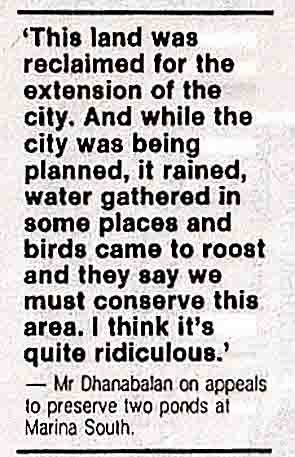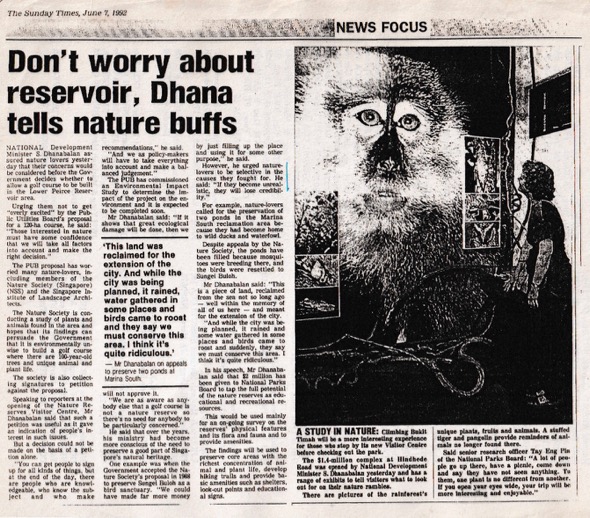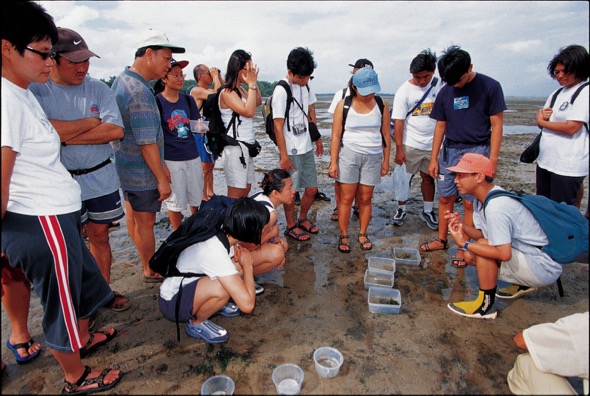Earlier posts: 1. Introduction; 2. Sungei Buloh; 3. Kranji Heronry; 4. Khatib Bongsu; 5. Senoko; 6. Marina South; 7. Punggol Grassland; 8. Lower Peirce; 9. Chek Jawa; 10. Bidadari; 11. Bukit Brown; 12. Albizia Woodland; 13. MacRitchie Forest.
With benefit of hindsight, I am putting on record my summarised analysis of what went wrong (or right) with the many Conservation Committee’s proposals after its initial success with Sungei Buloh.
The reasons for the Conservarion Committee’s two decades of failed conservation efforts are listed below so that we can learn from our past mistakes and not continue to repeat them in the future.
1. We were all new to nature conservation then. For years we were trying to encourage people to be interested in the local nature. Suddenly we were thrust into the role of conservation activists as a result of the Sungei Buloh success.
2. We were naïve, thinking that coming up with areas of plentiful birds would convince the authorities to set them aside as nature areas. Richard Hale, the person responsible for Sungei Buloh, understood nature conservation more than any of us locals. But then he gracefully stepped down to allow locals birdwatchers to lead.

3. Almost all the habitats submitted for conservation could be replicated within a few years to a decade or so. The most absurd habits suggested included grasslands, disused cemeteries and reclaimed areas (above).
4. Every conservation proposal included a list of birds found in the area. This inflate the number and impresses the public but it does not represent the actual birdlife of the area. Many of the bird species once seen may not return. What is more useful are lists taken every 6 to 12 months, to provide current data.
5. The Conservation Committee lacked priorities. Every and any area with plentiful birds were deemed worthy of conservation. But when it came to matured protected forests as in Lower Peirce (to build a golf course) and MacRitchie forest (threatened by the cross-country line) the committee was nowhere to be seen. It is strongly suggested that the Conservation Committee be renamed Bird Committee so as not to mislead the public.

6. To date, the Nature Sociery’s only two conservation successes are Sungei Buloh and Lower Peirce (above). The first was getting government to conserve a patch of degraded mangrove at Sungei Buloh as a bird sanctuary. The second was convincing government not to destroy a patch of forest at Lower Peirce for a golf course.

7. For the records, there were claims that there was a third success, Chek Jawa. But Chek Jawa was the result of the groundswell of public opinion that convinced government mot to reclaim the piece of intertidal area at Pulau Ubin rich in marine organisms (above). In fact, this was the only conservation effort that the Nature Society was not directly involved in, maybe only after the battle was won. And the Conservation Committee was, as usual,nowhere to be seen.
8. In the years to come there will be pressure for more areas to be cleared for development, even protected Nature Reserves. We have the Bukit Timah Nature Reserve, a patch of the original tropical rainforest. We also have a large area of Central Catchment Nature Reserve, that serves as a water catchment for our impounding reservoirs. Both areas are protected under law as Nature Reserves. It is such forests that we, as nature conservationists, should fight to protect from development – not patches of young habitats that can be easily replicated.
YC Wee
Singapore
3rd September 2017
Secretary, Malayan Nature Society (Singapore Branch) 1978-1990
Founding President, Nature Society (Singapore) 1990-1995








